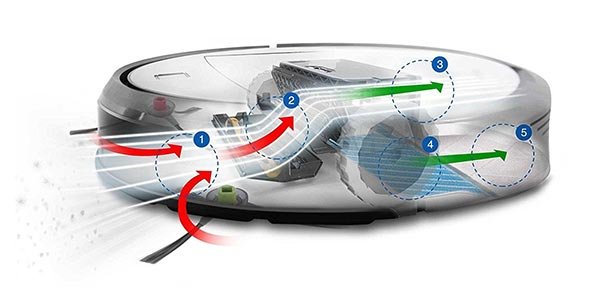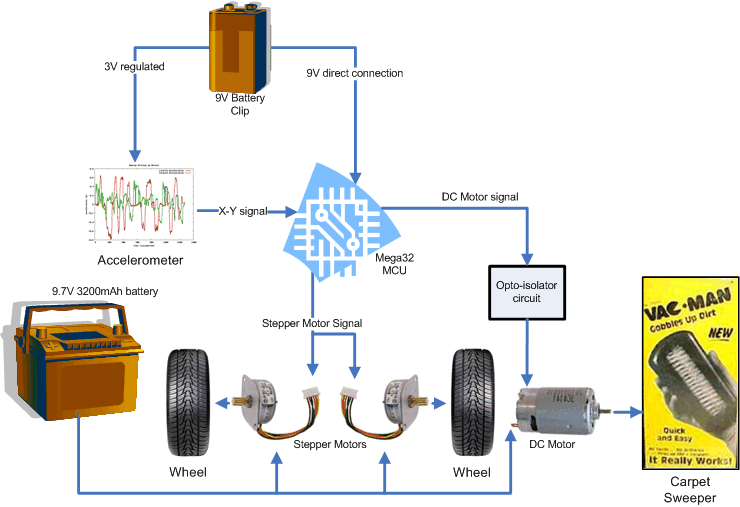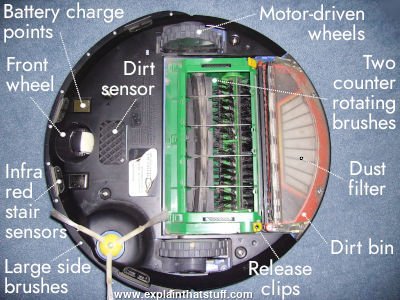What are Robot Sweepers?
If you’re tired of sweeping the floor with a broom, then you’ll be glad to know that there are robot sweepers that can do the job for you! Wondering what a robot sweeper is? Let’s find out!
Definition of Robot Sweepers
A robot sweeper is a small robot that moves around your home or workplace to collect and dispose of dirt, dust, and debris. They use sensors to navigate your floors, so they don’t bump into things or fall down the stairs.
Types of Robot Sweepers
There are different types of robot sweepers available in the market. Some sweepers are small and designed for homes, while others are large and meant to clean commercial spaces, such as malls and airports. Some robot sweepers can also mop the floor in addition to sweeping.
Advantages of Robot Sweepers
There are several advantages to using a robot sweeper. Firstly, they save you time and energy by doing the sweeping for you. Secondly, since they’re small and can easily move around furniture, they can clean hard-to-reach areas, such as under the bed or sofa. Thirdly, they can help to improve air quality by removing dust and allergens from your floors.
In summary, robot sweepers are small robots that can clean your floors for you. They come in different sizes, and some can even mop your floors. Using a robot sweeper can save you time and energy, clean hard-to-reach areas, and improve your home or workplace’s air quality. Pretty neat, right?
How Do Robot Sweepers Work?
If you’re wondering how robot sweepers work, you’re not alone! Robot sweepers are a cool invention that helps clean your floors with no effort on your part. Let’s explore the technology behind these machines!
Sensors and Navigation Systems
Robot sweepers are equipped with sensors to help them navigate around your home. These sensors detect obstacles, such as furniture or walls, and allow the robot sweeper to move around without bumping into things. Some robot sweepers even have cameras or lasers to help them map out the room and avoid anything in their path.
Cleaning Mechanisms
Robot sweepers have different cleaning mechanisms, depending on the model. Some use brushes to sweep up dirt and debris, while others use suction to collect dust and particles. Some even use a combination of both. Some robot sweepers also have a mop attachment to clean your floors even further.
Power Source and Battery Life
Robot sweepers typically run on rechargeable batteries. The battery life will depend on the model and how often you use it, but most robot sweepers can clean for about one to two hours before needing to be recharged. You can either plug the robot sweeper directly into an outlet or put it on a charging dock.
Now that you know how robot sweepers work, you can sit back and relax while this amazing machine does all the work for you!

Sensors and Navigation Systems
When you look at a robot sweeper, you might wonder how it knows where to go and what to clean. Well, robot sweepers use different sensors and navigation systems to navigate through your home and detect dirt and debris.
Laser Sensors
One type of sensor used by robot sweepers is laser sensors. These sensors emit lasers that bounce off objects and create a map of the room. This allows the robot sweeper to navigate through furniture and other objects while cleaning.
Ultrasound Sensors
Another type of sensor used by robot sweepers is ultrasound sensors. These sensors send out high-frequency soundwaves that bounce off objects and create a map of the room. Robot sweepers use this information to avoid obstacles and avoid getting stuck in tight spaces.
Infrared Sensors
Robot sweepers also use infrared sensors to detect objects in their path. These sensors work by detecting the heat that is emitted by objects and can help robot sweepers navigate around furniture and other obstacles.
Camera Systems
Some robot sweepers also use camera systems to detect dirt and debris. These cameras take pictures of the floor and analyze them to determine where the dirt and debris are located. This helps the robot sweeper navigate towards the areas that need to be cleaned.
Mapping Technology
Lastly, robot sweepers use mapping technology to create a map of your home. This map is used to help the robot sweeper navigate and clean your home efficiently. The robot sweeper uses its sensors and mapping technology to determine which areas have already been cleaned and which areas still need to be cleaned.
Overall, robot sweepers are pretty cool and use advanced technology to keep your home clean. With their various sensors and navigation systems, they can navigate through your home, avoid obstacles, and find dirt and debris to clean.

Cleaning Mechanisms
When you see a robot sweeper zooming around your house, have you ever wondered how it gets everything clean? There are actually different cleaning mechanisms that robot sweepers use to ensure your floors are free from dust and dirt. Let’s take a closer look!
Brush Rollers
One way that robot sweepers clean your floors is through brush rollers. These rollers rotate and use bristles to pick up dirt and hair from your floors. Some robot sweepers even have two brush rollers that rotate in opposite directions to get an even better clean.
Vacuum Suction
Another key cleaning mechanism in robot sweepers is vacuum suction. Just like your regular vacuum cleaner, robot sweepers have suction power to suck up dirt and dust from your floors. Some advanced models even have multiple levels of suction to adapt to different types of flooring.
Mopping
Robot sweepers don’t just stop at picking up dirt and dust – some of them can also mop your floors! They come equipped with water tanks and mopping pads to give your floors a deeper clean. However, it’s important to note that mopping can take more time than just sweeping or vacuuming.
UV-C Sanitization
Lastly, some robot sweepers also come with UV-C sanitization technology. This means that they emit ultraviolet light that can kill bacteria and viruses on your floors. It’s like having a mini disinfecting robot to keep your home as clean and safe as possible.
Well, now you know all about the different cleaning mechanisms that robot sweepers use to keep your floors spick-and-span. Happy cleaning!

Power Source and Battery Life
If you ever wonder how robot sweepers work, one crucial thing to pay attention to is its source of power. Just like you need energy to move, so do these robot sweepers. Let’s go deeper into the subject of power sources and battery life.
Lithium Ion Batteries
Most robot sweepers on the market today use lithium-ion batteries, just like some of the gadgets that you probably use, such as your tablet, phone, and laptop. Lithium-ion batteries are capable of storing a lot of energy and are lightweight than traditional batteries, making them ideal for robot sweepers.
Charging Stations
Robot sweepers need to be charged, and they do so via charging stations. You might have noticed these stations at your home or in public places. Robot sweepers return to the charging station when their batteries run low or when their cleaning task is completed.
Battery Life Expectancy
The battery life expectancy of a robot sweeper depends on the model, frequency of use, and charging habits. Most robot sweepers can last three to five years, with battery life ranging from one to two hours on a single charge. However, some advanced models can go up to two and a half hours. Furthermore, some models have a feature that allows them to go back to their charging station for a recharge and resume their cleaning task from where they left off.
Knowing how robot sweepers work can help you decide which model to purchase and how to care for it. Make sure to check the battery life and charging station features when purchasing a robot sweeper for your home.

Types of Robot Sweepers
If you’re tired of constantly sweeping or mopping your floors and want a helping hand, look no further than robot sweepers. But did you know that there are different types of robot sweepers available in the market? Let’s explore them!
Robotic Vacuums
Robotic vacuums are the most popular type of robot sweepers. They’re designed to navigate through your home and pick up dust, hair, and other debris from your floors. They use sensors to detect walls, furniture, and other obstacles to avoid collisions. These sensors also help the robot vacuum to map out your floor plan and clean each area thoroughly. Some robotic vacuums even have advanced features like voice control and app connectivity, which allow you to clean your floors without even leaving the couch!
Robotic Mops
Robotic mops work similarly to robotic vacuums, but instead of suction, they use water and cleaning solutions to mop your floors. They’re great for homes with hard floors, such as tile, hardwood or linoleum. Like robotic vacuums, they use sensors to navigate through your home and avoid obstacles. Some models come with a built-in water tank and can dispense the right amount of water for each cleaning job. With this type of robot sweeper, you can sit back and relax while your floors get the mop treatment they need.
Hybrid Robot Sweepers
Hybrid robot sweepers are a combination of robotic vacuums and robotic mops. They’re perfect if you want an all-in-one cleaning solution for your home. These robot sweepers use a combination of suction and water to clean your floors, and they can switch between the two modes depending on the type of flooring they’re cleaning. Hybrid robot sweepers often have larger dustbins and water tanks compared to their robotic vacuum and mop counterparts, so they can clean more area in one go.
In summary, robot sweepers come in different types to suit different types of floors and cleaning preferences. Whether you prefer a vacuum, mop, or a hybrid of both, a robot sweeper can help you keep your floors tidy with minimal effort.

Advantages of Robot Sweepers
If you’re tired of sweeping your floors or just want to save time, a robot sweeper might be a great option for you. These little machines can do the job for you while you sit back and relax. But how exactly do they work and what are the advantages? Let’s find out!
Convenience
One of the biggest advantages of robot sweepers is how convenient they are. You don’t have to spend time sweeping your floors every day because the robot does it for you. All you have to do is turn it on and let it do its thing. Plus, since it’s a small machine, it can easily go under furniture and into tight spaces that you might not be able to reach with a regular broom.
Efficiency
Robot sweepers are also very efficient at their job. They use sensors to detect where they need to go and what areas they need to clean. They also have brushes and suction to pick up dirt and debris. Plus, some models even have a mopping feature to leave your floors extra clean.
Lower Cost in the Long Run
While a robot sweeper might have a higher upfront cost compared to a regular broom, it can actually save you money in the long run. Since it’s more efficient at cleaning your floors, it means you won’t have to replace your flooring as often. Plus, it reduces the amount of dust and allergens in your home, which can help prevent health issues that could be costly in the long run.
Eco-Friendliness
Robot sweepers are also eco-friendly. Since they’re electric-powered, they don’t produce any emissions that could harm the environment. Plus, since they’re more efficient at cleaning your floors, they use less energy overall than a traditional vacuum.
Smart Home Integration
If you love using smart home technology, a robot sweeper is a great addition to your home. Many models can be controlled through an app or via voice commands with your smart speaker. This means you can turn it on and off, schedule cleanings, and even get alerts when it’s finished or needs maintenance.
Overall, a robot sweeper is a great investment if you want to save time, energy, and money while keeping your home clean.
Frequently Asked Questions
How long do robot sweepers last?
Robot sweepers are built to last for several years. With proper care and maintenance, they can last for up to 3-5 years. However, the lifespan of a robot sweeper depends on how often you use it and how you maintain it. You can extend the lifespan of your robot sweeper by cleaning it regularly, changing the filters, and replacing the brushes when needed.
Can you use a robot sweeper on carpets?
Yes, you can use a robot sweeper on carpets. Robot sweepers are designed to work on various surfaces, including carpets, hardwood floors, and tiles. Some advanced robot sweepers even come with carpet boost technology, which increases their suction power and picks up dirt and debris from carpets.
Are robot sweepers loud?
Most robot sweepers produce less noise compared to traditional vacuum cleaners. They usually make around 60 decibels of noise, which is similar to the sound of a conversation. Some robot sweepers have a quiet mode that reduces their noise level, making them ideal for homes with sleeping babies or pets.
Do robot sweepers work well on pet hair?
Yes, robot sweepers work efficiently on pet hair. They have specially designed brushes that can pick up pet hair and dander easily. Some robot sweepers have a HEPA filter that catches pet hair, dust, and allergens, making them ideal for homes with pets.
What happens if a robot sweeper encounters obstacles?
If a robot sweeper encounters an obstacle, it uses its sensors to detect the object and change its direction. Some advanced robot sweepers even have mapping technology that allows them to map out the room and avoid obstacles. If the robot sweeper gets stuck, it will send an alert to your phone so you can manually relocate it.
So there you have it, all your burning questions about robot sweepers answered!